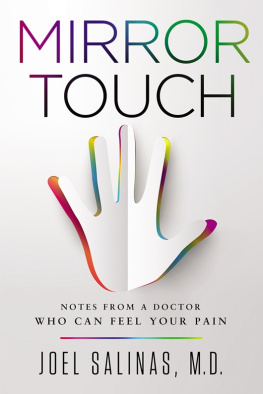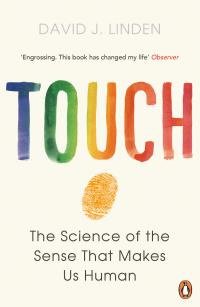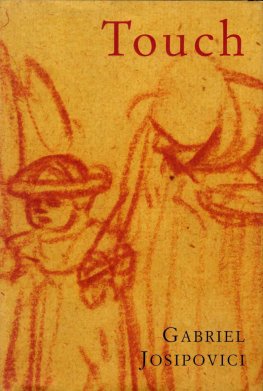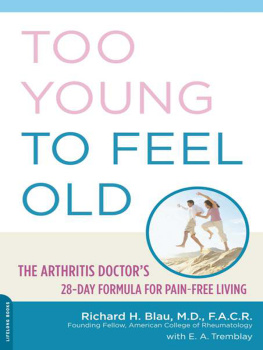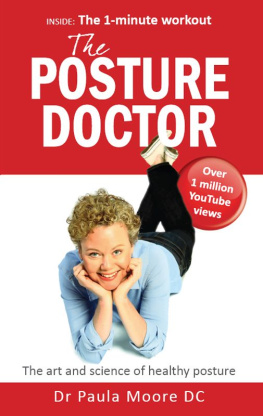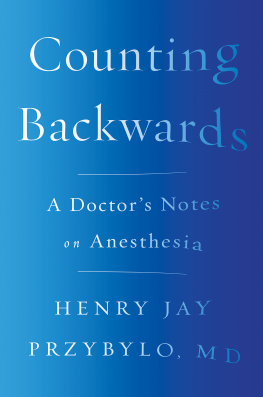Joel Salinas - Mirror Touch: Notes from a Doctor Who Can Feel Your Pain
Here you can read online Joel Salinas - Mirror Touch: Notes from a Doctor Who Can Feel Your Pain full text of the book (entire story) in english for free. Download pdf and epub, get meaning, cover and reviews about this ebook. year: 2017, publisher: HarperCollins, genre: Religion. Description of the work, (preface) as well as reviews are available. Best literature library LitArk.com created for fans of good reading and offers a wide selection of genres:
Romance novel
Science fiction
Adventure
Detective
Science
History
Home and family
Prose
Art
Politics
Computer
Non-fiction
Religion
Business
Children
Humor
Choose a favorite category and find really read worthwhile books. Enjoy immersion in the world of imagination, feel the emotions of the characters or learn something new for yourself, make an fascinating discovery.
- Book:Mirror Touch: Notes from a Doctor Who Can Feel Your Pain
- Author:
- Publisher:HarperCollins
- Genre:
- Year:2017
- Rating:4 / 5
- Favourites:Add to favourites
- Your mark:
- 80
- 1
- 2
- 3
- 4
- 5
Mirror Touch: Notes from a Doctor Who Can Feel Your Pain: summary, description and annotation
We offer to read an annotation, description, summary or preface (depends on what the author of the book "Mirror Touch: Notes from a Doctor Who Can Feel Your Pain" wrote himself). If you haven't found the necessary information about the book — write in the comments, we will try to find it.
Joel Salinas: author's other books
Who wrote Mirror Touch: Notes from a Doctor Who Can Feel Your Pain? Find out the surname, the name of the author of the book and a list of all author's works by series.
Mirror Touch: Notes from a Doctor Who Can Feel Your Pain — read online for free the complete book (whole text) full work
Below is the text of the book, divided by pages. System saving the place of the last page read, allows you to conveniently read the book "Mirror Touch: Notes from a Doctor Who Can Feel Your Pain" online for free, without having to search again every time where you left off. Put a bookmark, and you can go to the page where you finished reading at any time.
Font size:
Interval:
Bookmark:
To my parents, to my brother and
sister, and to those who entered my
life as patients, teachers, or both.
I BETRAY MYSELF.
During my first week as an internal medicine clerk, I was going through my patient list with the attending on duty when a code blue was called in the waiting room. Before the announcement on the overhead system finished ringing out, the attending and I were already bolting out the door. This was my first emergency, and I was eager to run through it.
Right around the corner from our office, a man was unconscious on the ground. His wife cowered in the corner, horrified. A young male nurse in dark blue scrubs pulled in a crash cart, which rattled with stocked emergency supplies. One of the medical residents started compressions. All around me were shouts of P.E.A.! P.E.A.! I could only make out a few of the medical directives in the alphabet soup yelled over the chaos. I took note of each abbreviation as best I could to keep up.
Or, at least I tried. I was absorbed in the man in cardiac arrest, fully immersed in his bodily experience. The sensations in my body mirrored the sensations in his. Compression after compression on his chest and on mine. I felt my own vocal cords tighten as doctors slid a tube down his throata sharp object shoved down the back of my throat. I told myself over and over that the man would be alright, that we would save him. Because thats what we do in medicine. We save people. After we save him, I assured myself, well discuss what worked, steps and procedures I can repeat the next time someone needed to be saved. But, as the doctors continued chest compressions, I felt my back pressed firmly against the linoleum floor, my limp body buckling under each compression, my chest swelling with each artificial breath squeezed into me through a tube, a hollow slipping sensation.
I was dying, but I was not.
After thirty minutes, the hospitalist called the code. The mans wife let out a wail, which was soaked in frayed black and oak. I stared intently at the dead mans body. I couldnt move. I lay there with him, dead. The absence of sensations in my own body, the absence of movement, the absence of breath, a pulse, any and all feeling. In my body, nothing but a deafening absence. I had to step away. I had to will myself to breathe.
I escaped into the nearest bathroom where I fell to my knees and felt the rest of my body rush toward my face. I vomited. I vomited until I started dry heaving. I was alive, though it felt as if I had died. I felt it, without a doubt, as sure as I could feel the tears and saliva currently spilling out of me in the bathroom stall. The contradiction brought my stomach into a knot once again. I had to stop. The rest of the team was going to wonder what had happened to me.
I took in a long deep breath. I flushed the toilet along with all of the turmoil that I had just expelled and stared at my reflection in the water. As the water settled, so did I. Another deep breath. I stood up and washed my face. I stared at myself in the mirror. This was me, I told my reflection, this was my body. I slowly felt embodied again, becoming in tune with the sensation of my clothes against my skin, the position of my arms and legs, the weight of my own flesh suspended on my bones, my heartbeat, my pulse, my rising and falling breaths. The hum of the paper towel dispenser was the last sound I heard before I finished wiping away what had happened. I was not going to let this happen again. Patients were going to rely on me. And I needed to be there for them. I was going to endure this and make it past pain, past death, past all the suffering I experienced to reach down and treat them in the throes of their illness. To process the echo of anothers darkest and most desperate anguish was my responsibility after I went home. I took one last deep breath as the door closed behind me.
M Y NAME IS J OEL S ALINAS. I AM A NEUROLOGIST AND A POLYSYNESTHETE , a person with multiple forms of synesthesia. Through mirror-touch synesthesia, one form of synesthesia, my body physically feels the experience of otherssometimes betraying me, losing me in the people I see before me.
At the conscious level, I feel the physical sensation of touch while observing it occur on another person. I am aware of the mental process taking place and can even describe the sensations in detail. Triggered automatically by sight, I feel a mirrored touch on parts of my body that correspond visually to whom Im looking at face-to-faceyour left, my right, your right, my leftlike in a mirror. But when I am standing next to a person, side-by-side, the location of my synesthetic touch is more likely to be anatomicalleft-to-left, right-to-rightas if we were in the same body.
Walking through the hospitals revolving door, for example, I see an elderly woman in a wheelchair. Shes dressed in a large worn tweed coat with dark floral embellishments and a burgundy knit hat covering a nest of gray hair that slips out from under the rim of the hat: I feel the sensation of vinyl pressed against the back of my thighs, sitting bent at the waist, sinking into the seat and coat, the snug fit of the womans hat around my forehead and scalp, my fingers laced together in front of my chest. I feel the movement of her eyes and eyebrows as she looks through the glass doors, then rests her gaze back down at the ground. Holding on to the handles behind her stands a volunteer. Hes next to the metal pole that extends from the wheelchair with a lime green plastic bag of belongings suspended like a bindle. Wearing an oversized salmon-colored shirt, the uniform of volunteers, the volunteer leans with his hip jutted toward his right: I feel the phantom contraction of muscles in my left hip, his glasses sitting invisibly on the bridge of my nose. The acne on his face peppers my own cheeks. Passing by the security guard at the welcome desk, I raise my ID badge: I feel the coiled plastic earpiece tucked around the security guards right ear around my left, the weight of his black wool suit on my arms and shoulders, the height and width of his towering frame, the fatigue in his eyes. Entering the long express line for early morning coffee at the hospitals main caf, I see other doctors, nurses, therapists, patients, custodians, administrators: each is a different channel, a different collection of feelings and expressions. My brains perception of bodily sensations surfs across them as my eyes pass over each. I line up behind a mother holding her baby over her left shoulder. She rocks from side to side. I feel the weight of the baby against my left shoulder, the tender sway of my torso rocking from side to side, the bob of her hair brushing up against the back of her neck. I feel the baby, the roundness of our faces, the clutching of our tiny hands. We look at each other. The baby smiles and I feel the smile on my face, and then my own smile realizes it.
While mirror-touch synesthesia is relatively rare, the most common form of synesthesia is likely grapheme-color synesthesia where each grapheme (the collective term for all written forms of numbers and letters) evokes the experience of a specific color. Regardless of the actual color of whats written, I simultaneously see its synesthetic colors layered cryptically on top. In the individual letters of the word cat, for example, C is black, A is red, and T is red-orange. And collectively, the word cat evokes clouds of color from each letter, which appear as a nebulous black haze with puffs of red and Montana dust.
My synesthesia also goes beyond neurologically colored numbers and letters. I can perceive motion as sound, music as color, taste as shapes as well as a wide variety of other exotic manifestations. About 4 percent of the general population have some form of synesthesia, including the physicist Richard Feynman, and the music producer Skrillex. Though synesthetic traits can exist in anyone, there seems to be a historically higher prevalence of synesthesia among artists. The ranks of legendary musicians with synesthesia include Jimi Hendrix, Stevie Wonder, Billy Joel, Tori Amos, and Eddie Van Halen, to name a few. Through its vast combinations of sensory associations, synesthesia erodes the barrier between the mundane and the electric, the predictable and the unknown, granting musicians, writers, artists, and cultural innovators the ability to share their synesthetic world in provocative ways. Franz Liszt, for example, famously conducted his orchestra with requests for more violet tones, while Marilyn Monroe reportedly saw colorful vibrations with sound. In his autobiography Vladimir Nabokov explained in vivid detail his correlation between colors and the alphabet, gorgeously describing the letter S as a curious mixture of azure and mother-of-pearl. I, on the other hand, experience the letter S like a fall squash, an autumnal mixture of yellow and orange, an amber-tone sibilant.
Font size:
Interval:
Bookmark:
Similar books «Mirror Touch: Notes from a Doctor Who Can Feel Your Pain»
Look at similar books to Mirror Touch: Notes from a Doctor Who Can Feel Your Pain. We have selected literature similar in name and meaning in the hope of providing readers with more options to find new, interesting, not yet read works.
Discussion, reviews of the book Mirror Touch: Notes from a Doctor Who Can Feel Your Pain and just readers' own opinions. Leave your comments, write what you think about the work, its meaning or the main characters. Specify what exactly you liked and what you didn't like, and why you think so.

